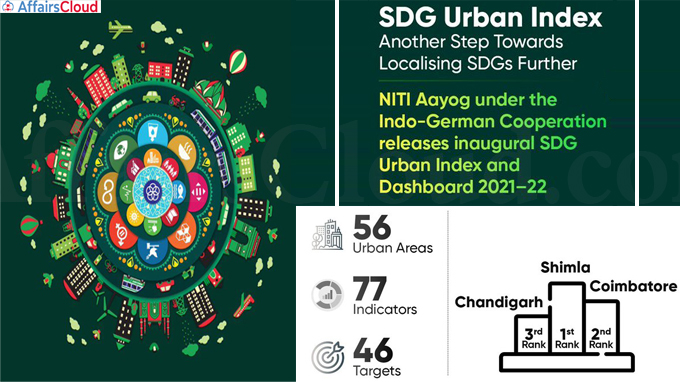
On November 23, 2021, NITI (National Institution for Transforming India) Aayog launched the first SDG (Sustainable Development Goal) Urban Index & Dashboard 2021-22. It was launched by Dr Rajiv Kumar, Vice Chairperson, NITI Aayog; and Prof Dr Claudia Warning, Director General, BMZ (Federal Ministry for Economic Cooperation and Development), Germany.
- It is a SDG progress monitoring tool at the ULB (Urban Local Body) level.
- This launch is a result of NITI Aayog, GIZ (Deutsche Gesellschaft für Internationale Zusammenarbeit), and BMZ collaboration under the umbrella of Indo-German Development Cooperation.
Significance of Index and Dashboard:
i.To further strengthen SDG localization and institute robust SDG monitoring at the city level.
ii.To highlight the strengths and gaps of ULB-level data, monitoring, and reporting systems.
Assessment:
The SDG Urban Index and Dashboard ranks 56 urban areas on 77 SDG indicators covering 46 global SDG targets across 15 SDGs.
- The data on these indicators have been sourced from official data sources such as National Family Health Survey (NFHS), National Crime Records Bureau (NCRB), Unified District Information System for Education (U-DISE), data portals of various ministries, and other government data sources.
The statistical methodology for the SDG Urban Index is based upon globally accepted methodology developed by the Sustainable Development Solutions Network (SDSN). It was finalized in close collaboration with the Ministry of Statistics and Programme Implementation (MoSPI). The indicators are also aligned with MoSPI’s National Indicator Framework.
Key Points:
i.SDG 14 (life below water), and SDG 17 (partnerships for the goals) have not been included.
ii.Out of 56 urban areas ranked in the index, 44 are with populations of above one million.
- 12 are State capitals with a population of less than a million.
iii.For each SDG, the urban areas are ranked on a scale of 0-100. A score of 100 implies that the urban area has achieved the targets set for 2030. The Urban areas have been classified as below based on their composite score:
- Aspirant: 0–49
- Performer: 50–64
- Front-Runner: 65–99
- Achiever: 100
Table showing Top 5 Urban Areas:
| Rank | Urban Area | State/Union Territory (UT) | Composite Score |
| 1 | Shimla | Himachal Pradesh | 75.50 |
| 2 | Coimbatore | Tamil Nadu | 73.29 |
| 3 | Chandigarh | Chandigarh | 72.36 |
| 4 | Thiruvananthapuram | Kerala | 72.36 |
| 5 | Kochi | Kerala | 72.29 |
Table Showing Bottom 5 Urban Areas:
| Rank | Urban Area | State/Union Territory (UT) | Composite Score |
| 1 | Dhanbad | Jharkhand | 52.43 |
| 2 | Meerut | Uttar Pradesh | 54.64 |
| 3 | Itanagar | Arunachal Pradesh | 55.29 |
| 4 | Guwahati | Assam | 55.79 |
| 5 | Patna | Bihar | 57.29 |
Other Highlights from Index:
i.According to the index, 55 out of 56 urban areas assessed under SDG 2 (Zero hunger) have 25% anaemia prevalence among women aged 15-49 years.
ii.96.4% of urban areas have a pupil-teacher ratio at the secondary level of less than 30 in the assessed cities.
iii.21 out of 56 areas treat 100% of their generated municipal solid waste.
iv.19 out of 56 areas have a sex ratio at birth greater than or equal to 950.
v.Atleast 9 in 10 households have access to improved sanitation facilities in 35 out of the total accessed cities.
vi.83.92% of 56 urban areas have skill development centres.
Toppers in Different SDG categories:
| SDG Category | Topper | Score |
| 1: No Poverty | Coimbatore, Tamil Nadu | 87 |
| 2: Zero Hunger | Kochi, Kerala | 80 |
| 3: Good Health & Well Being | Shimla, Himachal Pradesh | 80 |
| 4: Quality Education | Thiruvananthapuram, Kerala | 96 |
| 5: Gender Equality | Kochi, Kerala | 97 |
| 6: Clean Water and Sanitation | Bhopal, Madhya Pradesh | 92 |
| 7: Affordable and Clean Energy | Shimla, Himachal Pradesh | 99 |
| 8: Decent Work and Economic Growth | Bengaluru, Karnataka | 79 |
| 9: Industry, Innovation and Infrastructure | Surat, Gujarat | 78 |
| 10: Reduced Inequality | Amritsar, Punjab | 97 |
| 11: Sustainable Cities and Communities | Nashik, Maharashtra | 92 |
| 12: Sustainable Consumption & Production | Agra, Uttar Pradesh | 100 |
| 13: Climate Action | Aizawl, Mizoram | 100 |
| 16: Peace, Justice and Strong Institutions | Panaji, Goa | 98 |
SoI signed between NITI Aayog and BMZ
During the launch event, a Statement of Intent (SoI) was also signed between NITI Aayog and BMZ to promote cooperation between India and Germany. Under this SoI, “NITI- BMZ Dialogue on Development Cooperation” will be established for periodic bilateral discussions, sharing of developmental policy experiences and to review other ongoing bilateral programs.
- It will be bi-annual Dialogue (once in two years) to be led by the Vice Chairman, NITI Aayog and the Director General responsible for South Asia cooperation, BMZ.
- The first Dialogue is expected to be held February 2022.
- Both Sides will also conduct joint research to assist in the formulation of policies to address multi-sectoral challenges.
Other Participants:
Philipp Knill, Head of South Asia Division BMZ; Dr Julie Reviere, Country Director, GIZ India; Georg Jahnsen, Head of Sustainable Development of Smart Cities Project, GIZ India; Ms Sanyukta Samaddar, Adviser (SDG), NITI Aayog, and other senior officials from the two sides.
Recent Related News:
On September 16, 2021, a report titled ‘Reforms in Urban Planning Capacity in India’ was released by NITI Aayog’s Vice Chairman Dr Rajiv Kumar, CEO (Chief Executive Officer) Amitabh Kant and Special Secretary Dr K. Rajeswara Rao.
About NITI (National Institution for Transforming India) Aayog:
Establishment– 2015
Chairperson– Prime Minister of India (Currently- Narendra Modi)
Headquarters– New Delhi, Delhi




